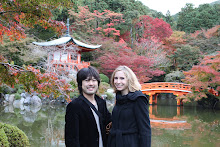Day Trip to Shimoda (In Izu)
This past Saturday, we were in the mood for both a drive and some sushi (sashimi, more specifically), so we took a lovely day trip to Shimoda, at the southern tip of the Izu peninsula.
Shimoda has quite a bit of historical significance for being such a small current-day town: it was a major port between Osaka and Edo (Tokyo) during the Edo Era, several of Perry's 'black ships' landed here, and the first American consulate was also opened at Gyokusen-ji (a temple). The Treaty of Amity and Commerce, which opened the ports of Edo (again, present-day Tokyo) and 4 other Japanese cities to American ships was signed here at Ryosen-ji (another temple).. Finally, the Treaty of Shimoda was signed in this city (hence the name!!), which marked the beginning of official relations between Japan and Russia.
It seems a bit ironic that one of the very treaties signed in Shimoda, the Treaty of Amity and Commerce, also brought about its decline as a port city. After Yokohama was opened to American ships, the American consulate moved there, and Shimoda port was again closed to the US.
Present day, there are just over 25,000 people residing in Shimoda, and it's mostly famous for great seafood, hot springs, beaches, and as a historical tourist attraction.
Our first stop was lunch, seeing as we arrived there just after 2:30. We are not good at getting out of the house before 11 a.m. on weekends, what can I say.
After a delicious and very reasonably-priced meal of sashimi rice bowls, we walked around the town for a bit, stopping in order to take some pictures of local temples and also to buy some manju. I may have talked about manju before, but if not, it's a traditional Japanese treat: basically, it's composed of 2 parts--sweet red bean paste (anko) that's been wrapped in sticky rice pounded until it becomes a sort of pasty dough (motchi). This is a terrible and un-appetizing description of manju however, and I highly encourage you to try it for yourself if you ever get the chance. It doesn't taste beany or gross at all.
The little sweets shop that we stopped in had all kinds of gorgeously formed varities of manju, including some that looked like little demons, flowers, bunnies, you name it. And of course, some in the shape of Perry's famous ships. These weren't true manju in the sense of the word, since the outside was something akin to the stuff ice cream cones are made of, but the inside was still anko. I just can't remember the specific name of this variety at the moment.
All in all, another great day, especially since we got to see a natural hot spring park on the way back, something that we had somehow never discovered before. We also drove by a shop named 'Wasabi no Neko-ya', which translates to 'Cat shop specializing in wasabi'. Of course we stopped there, too! Sadly, there were no cats to be seen, and the clerk couldn't say why the store was so named. They did have a great wasabi-flavored nori (seaweed) however, so all was not in vain.
Amazing sashimi rice bowls (yes, there is rice hiding under all that)
Adorable little demon manju
Wasabi no Neko-ya, the wasabi product store that had nothing whatsoever to do with cats

















0 comments:
Post a Comment